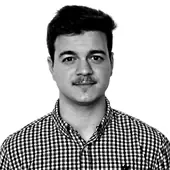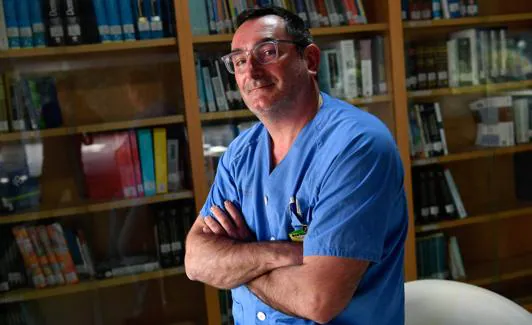Doctor Joaquín Moya, this Tuesday, at the Reina Sofía hospital. /
Traumatologist at Reina Sofía and member of the European Knee Society
The Murcian traumatologist and his colleague Vicente J. León, members of the unit of this joint of the Reina Sofía hospital, are the first doctors to join the European Knee Society
The high level of medical professionals in Spain in general, and in the Region of Murcia in particular, continues to receive honors. The tireless and outstanding work that is carried out in the different branches of this science continues to recognize the value that the Community has, either for its hospitals or for the doctors themselves. Among the latter there are two that are not only standing out in the Region. Neither in Spain. Joaquín Moya from Murcia and Vicente J. León from Valencia have been appointed members of the European Knee Society (EKS). They are the first Spanish doctors to join this prestigious organization. Both work in the Traumatology Service of the Reina Sofía hospital, whose head of service is Patricio Martínez, and they are part of the Knee Unit along with four other colleagues. This part of the body is his specialty. The Murcian doctor Joaquín Moya knows all his secrets.
-How did it all start and why do you know so much about your knees?
– Born in Murcia, I was educated in my city and studied in Pamplona. In it I began to probe the subject of Traumatology, a specialty that I liked because I always practiced a lot of sport, especially tennis, and I knew that they had a special relationship due to the number of injuries that occur. Soon my interest in the whole branch began to arise, more specifically in the knee. I did my residency in Madrid, where I did my thesis and later had the opportunity to go to the United States. In New York I continued training for two years with the knee, especially in degenerative pathology, implants and sports injuries. At the age of 32 I returned to Murcia, where I entered the Murcian Health Service (SMS), and I have worked in Cartagena, La Arrixaca and this is my first year at the Reina Sofía hospital.
-How was the way to get to the European Knee Society?
-I got in touch with Vicente a few years ago and together we have become more interested in knee surgery. We have carried out a lot of research work, to consider joint operations and, over time, to try to enter the European Knee Society (EKS). There was no Spanish and I had been lucky enough to receive a scholarship from the EKS with which I was in different important centers for a month, and that was the beginning of everything. We started the application and we were accepted. I have entered as a junior member and Vicente as a senior member. It is a real pride and encourages you to continue publishing, to do more complex cases and, ultimately, to fall more in love with the profession.
-What does a traumatologist have to do very well to enter the EKS?
-There are three fundamental pillars. The first is based on performing a minimum volume of between 50 and 100 annual knee surgeries. It is mainly about prostheses, when a degenerative problem occurs, such as osteoarthritis, and this part of the body suffers such wear and tear that it cannot be rescued, so an artificial piece must be placed. The second pillar is the publications made around degenerative pathology of the knee. You have to do a minimum of ten studies in the last five years. And finally, you need sponsorship or support from two active members of the EKS and finally all that record is approved in the assembly for them to approve your record. That we are the first Spaniards is a great satisfaction, but many more will come. Spain has a high level of Medicine.
Joaquín Moya: “Being the first Spaniards to join the European Knee Society is a source of pride, but more will come because we have a high level of medicine”
-Surgeries, studies, investigations, new treatments… gives time to everything. And from the hand of his partner. What are they up to now?
-I try to operate a lot with Vicente, do many joint cases, but not only with him, but with other colleagues from the Knee Unit, and at a scientific level the same. Now we are immersed in a study, a clinical trial in La Arrixaca, to try to prevent a deformity in the newborn’s knee. We believe that with a simple harness, placing it on this part of the body as soon as possible, this deformity can be prevented, which shows up late, when it can no longer be prevented with this device and very complex surgeries have to be performed. In addition, Vicente and I have founded the Institute for Advanced Knee Surgery (ICAR) with the aim of being able to treat patients who are not only in the Reina Sofía hospital and to promote research and surgery in this area. These are our closest challenges.
-The family must have had a lot to do with this passion for the profession.
-Yes, more from my grandparents. To some extent I didn’t suck it much from my parents either. I became interested in medicine because I wanted to be a surgeon. I wanted to do things with my hands, I didn’t see myself in an office for a long time and I liked being able to fix things myself. Within the career I approached Traumatology because of the sport, and because it is such a versatile and broad specialty.
Joaquín Moya and Vicente J. León, this Tuesday, at the Reina Sofía hospital. /
-Being so extensive… What does Joaquín enjoy the most?
-There is the entire sports branch, which perform arthroscopic operations, with small incisions, which you end up doing yourself with the experience you gain. Then you have all the part of the substitutive surgery, of putting implants, and all this that entails open operations, more bleeding, and, ultimately, more striking. I like both, I have no preferences, but we are now more focused on this second branch, where we are a bit more pioneering with alignment techniques and implants. The idea is to be prepared to apply a treatment that allows you to avoid putting a knee prosthesis on a young person.
Both doctors have founded the Institute for Advanced Knee Surgery (ICAR) to treat patients who are not only at the Reina Sofía and in order to promote research
– Does Traumatology only make you enjoy?
-There is a very gratifying part of our profession that comes when you improve the patient’s quality of life, but there are also more complex cases. You have to know how to handle failures because when things go well, everything is very nice: the patient is happy and the doctor too. But all these complex cases also imply that there is a high percentage of complications that can arise and are a total disaster for both the patient and the doctor. You take that home and it affects you. It has its very nice part but sometimes it goes wrong.
-He has had time to learn and do so many different things that he doesn’t seem to be 38 years old. What do you say to young people who are starting out on this path?
-At first it seems that there is an immense path, and that there are times that one throws you back. What you have to do is focus on what comes in the short term and, above all, put a lot of effort, work and dedication. As much as it seems that you are taking small steps, you have to be aware that all of this counts in the end and that nothing is achieved from one. Everything is based on perseverance and dedication. And there is also one important thing that should not be forgotten: it is vital to be well organized. One must know the time that has to dedicate at each moment to each thing. I have been very lucky because I have had good mentors, one of them Vicente, who is not only a friend or colleague, but also a great tutor who helps you make the right decisions in each phase of your career.
Vicente J. León, this Tuesday, at the Reina Sofía hospital. /
Vicente J. León: “We perform around 500 knee surgeries a year”
-How did Vicente León and Joaquín Moya come to the European Knee Society (EKS)?
-The EKS is a very limited company. It is made up of only about 77 senior members and then the juniors. To be able to enter, you first have to prove that you have significant background in knee surgery, that you dedicate yourself specifically to this, and then you have to prove it with the scientific part. You need the favorable report of, at least, two members of the EKS of recognized prestige who, let’s say, sponsor you, sponsor you, and those who present your CV a bit.
What does it mean to be part of this group?
-Being the first Spaniards fills us with happiness and pride. It is also a responsibility because, for example, in four days we have to go to the first rally and if you don’t go they say ‘See you later’. You have to submit jobs, keep up with all the updates. It is an encouragement to continue working and I think it will serve as an incentive for other colleagues to present their work.
-How many operations and publications do you develop per year?
-We can talk about 500 knee surgeries a year, including implants, meniscus operations, ligaments, prostheses, etc. I dedicate myself to performing comprehensive knee surgery, I do anything from a meniscus suture to the most complex operation, be it ligaments, the extensor apparatus, which are very beautiful and I like a lot, prostheses and even amputations. I work the whole spectrum of the knee.
-What is the most special treatment you have given to a knee?
-Since 2010, when I worked at Cieza, I have worked for many years with personalized cutting blocks, a technology to be used in knee prostheses. This study is perhaps the most special and the one that has been the protagonist of my doctoral thesis, which is based on the advantages and disadvantages of this type of system to place knee prostheses. And today what stands out to us the most at a national level is kinematic alignment, a philosophical way of understanding knee surgery with which we seek for the patient to once again have this part of the body aligned as it comes by constitution. It is a way to individualize and personalize the treatment more to each person. The sensations that we are seeing in patients is that it works a lot and it is something that is going to differentiate us at a national level.
#Joaquín #Moya #challenge #prevent #knee #deformities #neonates




Leave a Reply